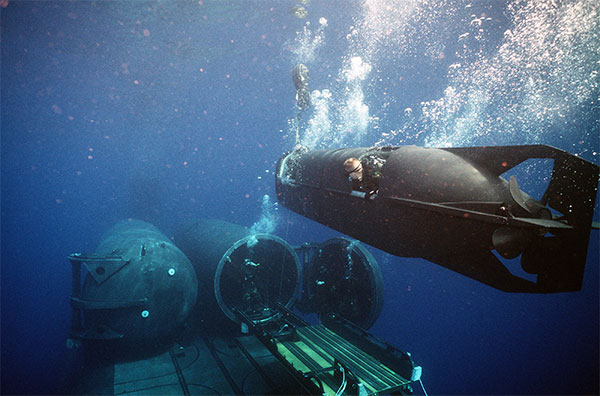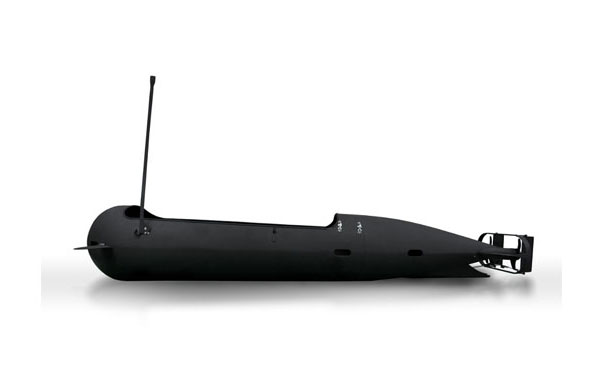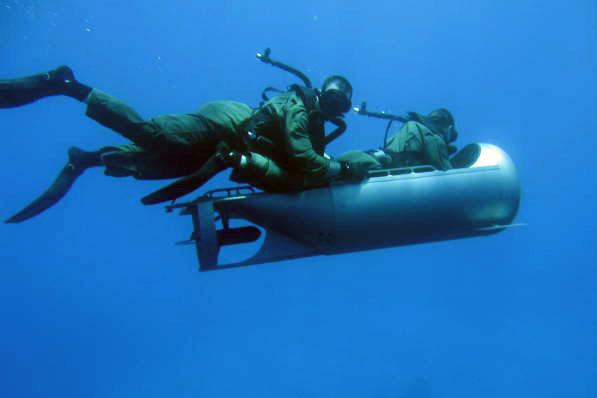Swimmer Delivery Vehicles (SDV)
The SBS use a variety of submersibles to carry out clandestine underwater operations. These mini-subs and driver propulsion vehicles are typically launched from submarine motherships and transport teams of SBS frogmen beneath the water to their targets.
The SBS have used a mixture of home-grown SDVs and off-the-shelf U.S. and British models.
Mk VIII Mod 1
In 1999 it was reported by Jane's Fighting Ships that the Royal Navy bought at least 3 Mk VIII Mod 1 SDVs from US manufacturers. These battery-powered mini-subs are able to carry 6 SBS frogmen up to 36 nautical miles.
Larger SDVs such as the MK VIII Mod 1 have a greater passenger / equipment capacity than smaller alternatives but may be harder to deploy in a clandestine manner. While they can be launched from surface ships, doing so typically requires a large vessel fitted with crane and such a deployment may require being well out of sight of the enemy coastline and therefore possibly out of SDV travel range. Another option is to transport the SDV to the water as an underslung helicopter load, although this risks damage to the SDV. The most clandestine method of deployment is to launch and recover the MK VIII Mod 1 from submerged submarines equipped with a dry deck shelter (DDS). (see image below). The Royal Navy Astute-class submarines have a global reach and can be fitted with a single DDS, the Special Forces payload bay. The payload bay can be attached and detached as needed.

In 2018 it was revealed that the Royal Navy had been cleared to buy a replacement fleet of SDVs in the form of the Shallow Water Combat Submersible (SWCS).
More infor / further reading
- SBS To Get New Minisubs
(Elite UK Forces Report)
Torpedo SEAL
The Torpedo SEAL is a small SDV that is piloted by a single frogman and can transport a passenger and mission equipment. The system gets its name from the fact that it fits inside a standard NATO 533mm torpedo tube. To deploy the Torpedo SEAL, SBS frogmen swim out of a submerged submarine - such as a nuclear-powered Astute-class attack sub - and pull the SDV out of the torpedo tube. It is then extended and ready to be operated. The Torpedo SEAL can also be airlifted by helicopter, launched from a surface ship or attached to the outer casing of a submarine.
The Torpedo SEAL is made by James Fisher Defence (JFD) and is part of their SEAL Pod range of SDVs. It has a range of 10 nautical miles and a top speed of 4 knots. It is powered by a Lithium Polymer battery driving 1 or 2 thrusters. It features the same Steering Information Navigation Control (SINC) system as the Sub SEAL SDV, also made by JFD.
The Torpedo SEAL may be used to deliver SBS sabotage teams. Launching from many miles off shore, the SBS frogmen use the Torpedo SEAL to infiltrate undetected into enemy harbours where they can attach explosives to berthed ships. News reports in May 2015 mentioned that the SBS were training with Torpedo SEAL SDVs to prepare for possible operations against people smuggling vessels based out of Libya.

related info:
- Torpedo SEAL
(James Fisher Defence website for the Torpedo SEAL (includes video)
Diver Propulsion Device
Smaller still than the Torpedo SEAL, the Diver Propulsion Device (DPD) is a SDV capable of transporting 2 divers and their gear either fully or partially submerged. DPDs allow combat divers to extend their effective range and to arrive on target with less fatigue than swimming unassisted.
DPDs are manufactured by U.S. company, STIDD Systems Inc. They are employed by many Naval special operations forces around the world, including the SBS. These units are small and light enough - 175lbs and 2.23 meters long - to be carried to and from shore by 2 men. They can be launched and recovered from surface vessels, such as the SBS 'Stealth Boat', and air-dropped under a parachute.
The DPD operates to a maximum depth of 30 meters and can travel at 1.2 knots. Range is 6.5 nautical miles. They are powered by a Lithium-Ion battery and propelled by a low-noise electronic thruster.
Basic models of the DPD incorporate a compass and depth gauge while more sophisticated variants house a moving map display and bottom scanning sonar.

related info:
- Diver Propulsion Device
(STIDD website for the the DPD (includes videos)








